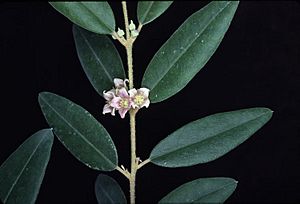Boronia lanceolata facts for kids
Quick facts for kids Boronia lanceolata |
|
|---|---|
 |
|
| B. lanceolata in the Australian National Botanic Gardens | |
| Scientific classification | |
 |
|
| Occurrence data from Australasian Virtual Herbarium |
Boronia lanceolata is a type of plant that belongs to the citrus family, called Rutaceae. You can only find it growing naturally in the northern parts of the Northern Territory and Queensland in Australia. This plant is a tall, bushy shrub with lots of branches. It has leaves that are shaped like an oval or a spear, and its flowers are white or pink with four petals. It's the most common type of boronia plant you'll see in the Northern Territory.
Contents
What Does Boronia lanceolata Look Like?
Boronia lanceolata is a shrub that stands upright and has many branches. It can grow up to about 250 centimeters (or 8 feet) tall. Its branches and leaves are covered with tiny hairs that look like stars.
Leaves and Stems
The leaves usually grow in pairs, directly opposite each other on the stem. They are shaped like an oval or a spear. These leaves can be anywhere from 8 to 90 millimeters long and 3 to 27 millimeters wide. Each leaf has a small stalk, called a petiole, which is 3 to 16 millimeters long.
Flowers and Fruit
The flowers of Boronia lanceolata are either white or pink. They grow in small groups of three to seven flowers. These groups appear where a leaf meets the stem, which is called a leaf axil. Each group of flowers grows on a short stalk, known as a peduncle, that is 0.5 to 9 millimeters long.
Unlike other boronia plants in the Northern Territory, the petals of Boronia lanceolata are longer and wider than its sepals. Sepals are the small, leaf-like parts that protect the flower bud. The four sepals are shaped like triangles or eggs, and they are 1 to 3 millimeters long and 1 to 2 millimeters wide. They don't get bigger as the fruit grows.
The four petals are 2 to 5.5 millimeters long and 1.5 to 3 millimeters wide. These petals actually grow larger as the fruit develops. You can see this plant flowering from May to February. The fruit is a small, dry seed pod called a capsule. It is 3 to 4 millimeters long and about 2 millimeters wide.
How Was Boronia lanceolata Named?
The plant Boronia lanceolata was officially described for the first time in 1859. This description was made by a scientist named Ferdinand von Mueller. He published his findings in a book called Fragmenta phytographiae Australiae.
The second part of its scientific name, lanceolata, is a Latin word. It means "spearlike," which describes the shape of its leaves.
Where Does Boronia lanceolata Grow?
This type of boronia plant grows in different kinds of natural areas. You can find it in heathlands, woodlands, and forests. It prefers to grow on sandstone soil.
Its natural home stretches from Mornington Island and Westmoreland in Queensland. It also grows as far west as the Macadam Range and Tiwi Islands in the Northern Territory. In the Northern Territory, it is the most common type of boronia plant.
Is Boronia lanceolata Protected?
The good news is that Boronia lanceolata is not considered to be in danger. Both the Northern Territory Government, under its Parks and Wildlife Conservation Act, and the Queensland Government, under its Nature Conservation Act 1992, classify it as being of "least concern." This means there are plenty of these plants, and they are not at risk of disappearing.

